Related Research Articles
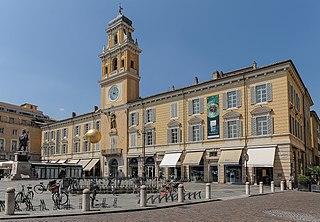
Parma is a city in the northern Italian region of Emilia-Romagna known for its architecture, music, art, prosciutto (ham), cheese and surrounding countryside. With a population of 198,292 inhabitants, Parma is the second most populous city in Emilia-Romagna after Bologna, the region's capital. The city is home to the University of Parma, one of the oldest universities in the world. Parma is divided into two parts by the stream of the same name. The district on the west side of the river is Oltretorrente. Parma's Etruscan name was adapted by Romans to describe the round shield called Parma.
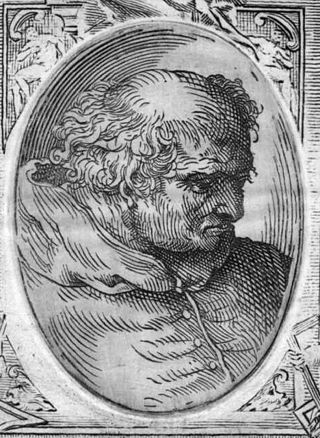
Donato Bramante, born as Donato di Pascuccio d'Antonio and also known as Bramante Lazzari, was an Italian architect and painter. He introduced Renaissance architecture to Milan and the High Renaissance style to Rome, where his plan for St. Peter's Basilica formed the basis of the design executed by Michelangelo. His Tempietto marked the beginning of the High Renaissance in Rome (1502) when Pope Julius II appointed him to build a sanctuary over the spot where Peter was martyred.

The Palazzo della Cancelleria is a Renaissance palace in Rome, Italy, situated between the present Corso Vittorio Emanuele II and the Campo de' Fiori, in the rione of Parione. It was built 1489–1513 by Baccio Pontelli and Antonio da Sangallo the Elder as a palace for Raffaele Cardinal Riario, Camerlengo of the Holy Roman Church, and is regarded as the earliest Renaissance palace in Rome.

Pienza is a town and comune in the province of Siena, Tuscany, in the historical region of Val d'Orcia. Situated between the towns of Montepulciano and Montalcino, it is considered the "touchstone of Renaissance urbanism".
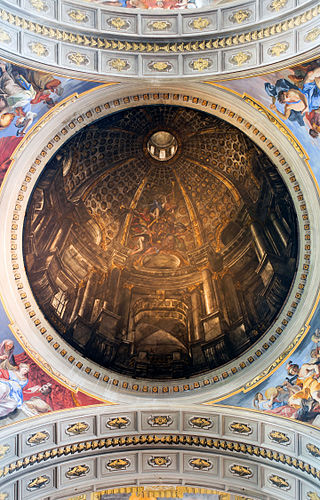
Illusionistic ceiling painting, which includes the techniques of perspective di sotto in sù and quadratura, is the tradition in Renaissance, Baroque and Rococo art in which trompe-l'œil, perspective tools such as foreshortening, and other spatial effects are used to create the illusion of three-dimensional space on an otherwise two-dimensional or mostly flat ceiling surface above the viewer. It is frequently used to create the illusion of an open sky, such as with the oculus in Andrea Mantegna's Camera degli Sposi, or the illusion of an architectural space such as the cupola, one of Andrea Pozzo's frescoes in Sant'Ignazio, Rome. Illusionistic ceiling painting belongs to the general class of illusionism in art, designed to create accurate representations of reality.

Giovanni Lanfranco was an Italian painter of the Baroque period.

Marcantonio Franceschini was an Italian painter of the Baroque period, active mostly in his native Bologna. He was the father and teacher of Giacomo Franceschini.

Sant'Ambrogio di Torino is a comune (municipality) in the Metropolitan City of Turin in the Italian region Piedmont, located about 25 km west of Turin in the Susa Valley.

The Ducal Palace, also known as Reggia di Colorno, is an edifice in the territory of Colorno, Emilia Romagna, Italy. The palace we see today was refurbished by Francesco Farnese, Duke of Parma in the early 18th century on the remains of a former castle.

The Palazzo della Pilotta is a complex of edifices located between Piazzale della Pace and the Lungoparma in the historical centre of Parma, region of Emilia Romagna, Italy. Its name derives from the game of pelota played at one time by Spanish soldiers stationed in Parma.
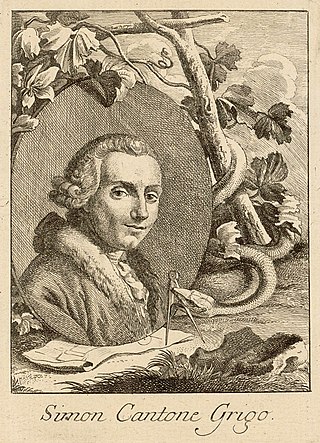
Simone Cantoni was a Swiss architect of the Neoclassical period, active mainly in Northern Italy.

San Vitale is a Baroque style, Roman Catholic church located in central Parma, region of Emilia Romagna, Italy. it stands just east of the Palazzo del Comune and Piazza Garibaldi.
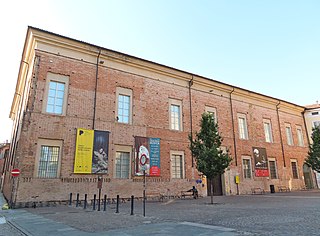
The Palazzo Cusani is a palace at Piazzale San Francesco #1 in the central Parma region of Emilia-Romagna, Italy.

Palazzo Comunale is a Gothic style palace located facing Piazza del Cavalli in the historic center of Piacenza, northern Italy which now serves as the seat of municipal administration. The facade is flanked by two bronze equestrian statues sculpted by Francesco Mochi and depicting the Farnese Dukes of Parma: Ranuccio (1612–20) and his father, Alexander (1620-1629). Across the piazza is the late-Baroque or early neoclassic Palazzo del Governatore (1787) designed by Lotario Tomba. Recessed and to the right is the 17th-century Collegio dei Mercanti.

The Palazzo Maffei Marescotti or Palace of the Vicariate is a religious building in Rome, Italy.
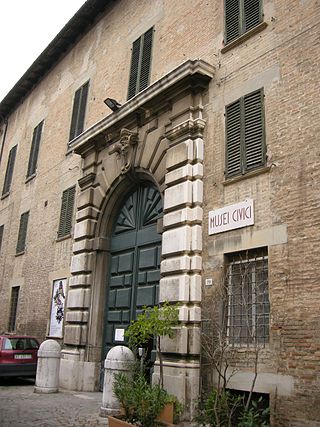
The Civic Museum of Palazzo Mosca is the main civic museum of Pesaro, displaying art and decorative works, located in Piazza Mosca in this town of the region of the Marche, Italy.

The Palazzo del Giardino or Palazzo Ducale del Giardino is a historic palace in the Parco Ducale in Parma. It is not to be confused with the official Parma residence of Marie Louise, Duchess of Parma between Palazzo della Pilotta and Palazzo della Provincia in what is now known as piazzale della Pace - she also lived at the Ducal Palace of Colorno and in the Casino dei Boschi in Sala Baganza. The main Ducal Palace in Parma, the Palazzo della Pilotta and the Reinach Theater were all destroyed in an early morning air raid on 13 May 1944, carried out by the 465th Heavy Bombardment Group of the US Airforce, 781st Squadron, which dropped 9 GP bombs on the city centre.
The Palazzo del Governatore is a monumental building located in Piazza Garibaldi forming part of the civic center of Parma, region of Emilia Romagna, Italy. The building still houses municipal offices, as well as hosting cultural and social events. Across the Piazza Garibaldi are a number of other prominent buildings including the Palazzi del Podesta and del Comune, and the neoclassical Church of San Pietro Apostolo.
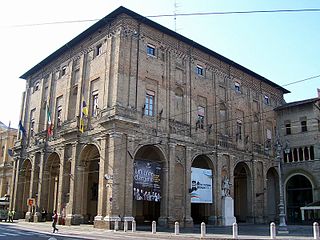
The Palazzo del Comune is a monumental building located in Piazza Garibaldi forming part of the civic center of Parma, region of Emilia Romagna, Italy. The building houses municipal offices. Across the Piazza Garibaldi are a number of other prominent buildings including the Palazzi del Podesta and del Governatore, and the neoclassical Church of San Pietro Apostolo.
References
- ↑ Sant'Ambrogio was demolished in the early 20th century.
- ↑ Tourism entry of Commune of Parma, on Palazzo Venturini.
44°48′00″N10°19′40″E / 44.80000°N 10.32771°E